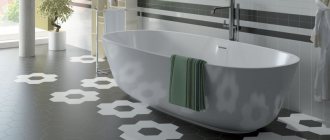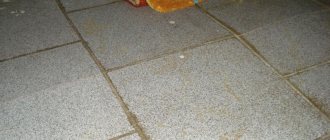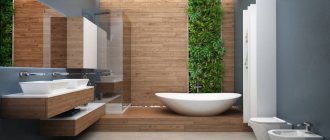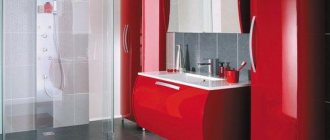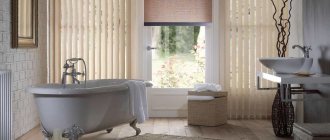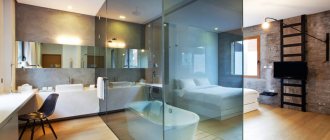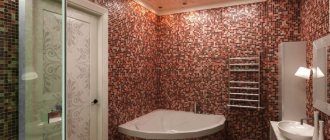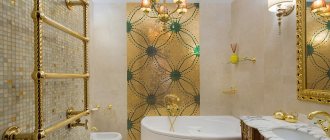The modern construction market offers a huge variety of different materials for repair and finishing work. With such a wide range to choose from, choosing a floor for your bathroom will not be difficult.
However, you should remember that not every material you like will be suitable for the bathroom, because this is the wettest part of all in the house.
From this article you will learn how to choose the right material for finishing the floor in the bathroom, what to pay special attention to, and also get acquainted with several design ideas for decorating the floor in the bathroom.
What to look for when choosing
First, you should evaluate the material according to important criteria:
- Environmental friendliness
- Durability
- Resistance to various damages and impacts
The floor in the bathroom is not only subjected to mechanical pressure and abrasion, it is also affected by high humidity and temperature, and frequent use of aggressive detergents.
Therefore, it is better to carefully select, thereby protecting yourself in the future from harmful influences, frequent cleanings and enjoying the attractive appearance of fresh renovations for many years.
What materials are best to avoid?
When choosing a bathroom floor, you should immediately avoid materials such as:
- Laminate
- Parquet
- Any carpeting
- Tree
- Linoleum
Taking into account the constant temperature difference, high humidity, poor ventilation, and the influence of chemicals, the listed materials will quickly lose their presentable appearance and fall into an unusable sanitary condition.
If you still really want to have a wooden floor in the bathroom, you will have to provide it with all the conditions, protect and cherish it.
In this case, it is most logical to take a closer look at bamboo. It is less susceptible to the negative influence of the aquatic environment.
Laying tiles with your own hands
The good thing about tiles is that a DIYer can lay them on his own bathroom floor. Let's briefly look at the installation steps:
- prime the prepared floor (waterproofing, screed, clearing of construction debris) and dry for an hour,
- choose the installation method: from the far visible corner, from the threshold or from the central mark,
- apply markings using a laser level,
- spread the prepared glue (choose waterproof, designed for wet rooms) onto the floor fragment and level it with a notched trowel,
- Apply the adhesive solution to the tile with the same spatula, having previously inspected it for defects on the front side,
- lay according to the markings, checking the accuracy with a square,
- To connect, tap each tile laid on the floor with a mallet (rubber hammer) or fist, collect excess glue with a spatula,
- lay out the surface with finishing material, leveling the gaps using crosses - spacers,
- Constantly check the evenness of the laying with a level,
- After a day, start grouting the joints using a special mixture.
Which material to choose
Currently, there are many materials suitable for laying bathroom floors.
It’s easier to first decide on the style of the future interior and choose suitable materials in accordance with it.
Natural stone underfoot
Natural stone is rarely used due to cost, but it is strong and durable and is a symbol of luxury.
Another disadvantage besides the price is the difficulty of selection, since even in the same batch the slabs are not of the same shade. Therefore, the selection of the drawing is entrusted to a professional.
Ceramic tile
The most common and reliable option is to lay tiles on the bathroom floor.
Ceramic tiles can withstand physical pressure very well. Bathroom floor tiles are usually coated with a special glass glaze.
It is this that protects the porous material from moisture penetration.
If a professional professional does the installation, the tiles will last for decades.
Look also here:
- Toilet in a small toilet
What color scheme to choose for the bathroom (60+ photos)
Hot tubs
It does not require special care. Unless you have to treat the joint seams with sealant from time to time to protect them from the growth of fungus and mold.
Types of freestanding bathtubs
By shape
- Oval bath
An oval freestanding bathtub is perhaps the most versatile option for almost any bathroom design. It can be larger or smaller, but in any case, with its smooth shapes and ergonomics, it will satisfy the aesthetic and practical requirements of the owners.
A bright wall accentuates a freestanding bathtub
- Rectangular bath
A rectangular bathtub should be chosen if the bathtub is still adjacent to the walls on one or more sides.
Idea! A freestanding rectangular bathtub will decorate your interior in a high-tech style.
Rectangular black and white bathtub
- Classic clawfoot bathtub
A freestanding clawfoot bathtub in a traditional design harkens back to the original designs of this piece. It looks solemn, bringing sophistication and special charm to the bathroom with its exquisite forms.
Important! The legs of a freestanding bathtub are a self-sufficient and bright element; carefully choose their shape and size.
Classic white bathtub with silver legs
- Round and custom bathtubs
Thanks to modern materials and the imagination of designers, finding a font of almost any shape will not be difficult. The only nuance is that too fancy products are more difficult to fit into the space.
The difficulties will more than pay off, since such a bathtub will become a real work of art in the interior.
Glass mosaic
This mosaic is made from specially fired glass. The production technology guarantees high wear resistance, absolute moisture resistance and impeccable appearance. You can evaluate it in the photo of the floor in the bathroom.
Caring for the floor will not cause any worries: water and stains are easily removed, cracks do not form.
The choice of this material is guaranteed to create a unique atmosphere and memorable decor. The only negative is the high cost, but it is compensated by a lot of useful qualities.
↑ Natural and artificial stone
Natural stone has been used to finish the floors of baths and swimming pools since ancient times. This coating has a long service life and is easy to clean. The most commonly used stones are granite, marble and limestone. However, the gifts of nature are not cheap, and connoisseurs of all things natural will have to pay a significant amount per square meter.
Natural stone floors are beautiful and easy to clean
Artificial stone (agglomerate) is in no way inferior in beauty to the creations of Mother Nature, and even surpasses them in strength. And the affordable price will allow everyone to realize the dream of a luxurious bathroom to match royalty.
It is important! Agglomerate is pieces of minerals bound by a synthetic substance.
The advantages of artificial stone include flexibility - the agglomerate plates, after pre-heating, can be bent and lined with uneven surfaces, while natural material is fragile and, if treated insufficiently, crumbles and breaks.
Vinyl tiles
Vinyl is resistant to most bathroom problems. Low cost, ease of installation and maintenance make this material popular among a wide range of consumers.
Look also here:
Installation of a septic tank. Ten steps- Small Toilet Design – 110 Real Photos
Bathroom design 2022 - 115 photos of interesting design ideas and new trends!
However, the wear resistance of this material is not up to par.
In addition, given that this material is artificial, it is not environmentally friendly.
How to choose the color of self-leveling floors
The colors and patterns can be completely different, from trendy to classic. This is evidenced by numerous photos of self-leveling bathroom floors.
However, when choosing, you need to take into account that the coating will be installed not for a couple of years, but for a good ten, or even more. And the colors that are fashionable today will lose their relevance tomorrow.
- Application of Kirchhoff's laws
Painted bathroom - overview of options for painting a bathroom (77 photos)
Bathroom hood - which one to choose? Review of popular models +80 photos
Therefore, it makes sense to give preference to the classics. It is also necessary to take into account that the ceiling and walls may change over a decade, and the floor will have to be suitable for new materials.
As for the specific choice of color and pattern, it all depends on the preferences of the owners. To be sure, you can use the services of a professional designer.
Floor waterproofing
Before laying decorative flooring, you should consider whether the bathroom floor needs waterproofing.
It will prevent possible leaks and thereby protect its owners from problems with neighbors. In addition, it will protect the concrete screed from moisture, and therefore protect it from destruction.
A water barrier is obtained by laying special materials on a concrete base: roll insulation or bitumen-based mixtures. This coating is carried out in those places where the possibility of flooding with water is maximum - the floor and the base of the walls.
Waterproofing does not cause any harm and does not interfere with finishing work. It only requires additional materials and some time to implement it. Therefore, everyone must decide for themselves whether it is needed or not.
Installation of a bathtub in the floor
- First you need to build a pit - an artificial depression in the foundation of the house. It should match the shape of the future bathroom, but be a little larger in size so that all systems can be freely installed. And the depth of the pit is usually 60-80 cm.
- After this, it is necessary to concrete the walls and floor of the recess.
Attention! Be sure to make a layer of waterproofing at least 11 cm thick.
- Next, you can bring water and drain pipes to the location of the future hatch.
- After this, we install the siphon and attach it to the bottom of the bathtub, and also cut the mixer into the sides of the bathtub.
- We insert the bathtub into the finished recess and connect it to the water supply and sewer pipes using corrugated metal hoses.
It is important to correctly connect communications when installing a bathtub in the floor
- After installation, it is necessary to conduct a test filling with water to ensure that there are no leaks and that all connections are tight.
- Tile the space around the perimeter of the bath with ceramic tiles. It is also necessary to make an overflow tray around the sides to protect against water leakage and flow back into the sewer.
The built-in bathtub is the center of the entire room. Therefore, it is worth paying special attention not only to the size and shape, but also to the finish, as well as your own safety. The bathtub body can be finished with waterproof wood, and the steps with anti-slip materials. There are many options to make your bathroom beautiful and multifunctional, the main thing is to use your imagination and listen to the advice of professionals.
Warm floor
Warm floors in the bathroom are a fashion trend. It's incredibly convenient. The floor in the bathroom will always be warm, no matter what material the top covering is made of.
Heated floors can be electric or water. Each system has its pros and cons.
So the electric one creates an additional electromagnetic field and increases energy consumption, but is easy to install.
The water option is difficult to organize, but it has no other disadvantages. Warm floors are suitable for almost any surface, especially tiles. The only caveat is that the floor itself will have to be raised a few centimeters.
Before carrying out repairs, you need to calculate and think through everything, and if you don’t have your own experience, you can consult with a specialist. Then the end result will be pleasing to the eye, and not frustrating with shortcomings.
Features of a freestanding bathtub
The appeal of a freestanding bathtub is easy to explain. It transforms the bathroom interior into a luxurious spa area. In addition, it is a bright central element of the room, which sets the mood in it.
Oval freestanding bathtub in a spa style bathroom
Like any custom design solution, a freestanding bathtub has strengths and weaknesses. Before including this object in your interior, it is important to familiarize yourself with them and think through everything to the smallest detail.
It is important to consider when choosing a free-standing bath:
- Room size
It is believed that a freestanding bathtub is more appropriate in a spacious room where it is possible to place objects without touching the walls. After all, this is exactly how – surrounded by free space – the bathtub looks most impressive.
But this does not mean at all that such a solution is categorically unsuccessful in a compact bathroom. Even if there is a wall on one side of a freestanding bathtub, its essence will not change. Visually, the font, on the contrary, will add volume and air to the room.
- Functional
The main function of the bath is, of course, hygienic. It should be convenient to wash in. From this point of view, a freestanding bathtub is an ambiguous solution.
Since the bathtub is not adjacent to the walls, keeping the room dry and clean will be a little more difficult. By choosing a free-standing bathtub, you are purchasing, first of all, a place for relaxation and meditative water procedures. It would be great if there is room in your bathroom for a shower corner. It will be more convenient to wash off the foam or rinse quickly in it.
Installation conditions
Installation of such a structure is possible only on private property. When designing a house, you should discuss the location of such a structure in advance. The frame part is made of iron and concrete. The high cost of such luxury in a home requires detailed study of all the nuances.
If you have finance, you can begin designing a sewer system that resembles a small pumping station, where there is also a system for filtering and purifying water. The volume of an average bath is up to four hundred liters. This is why cleaning will be much cheaper.
Bathroom installation requires the presence of qualified specialists. Independent work is quite difficult to do, however, if you have the desire, then it is quite possible to do it. You just need to first carefully read the detailed installation instructions and follow their recommendations step by step.

